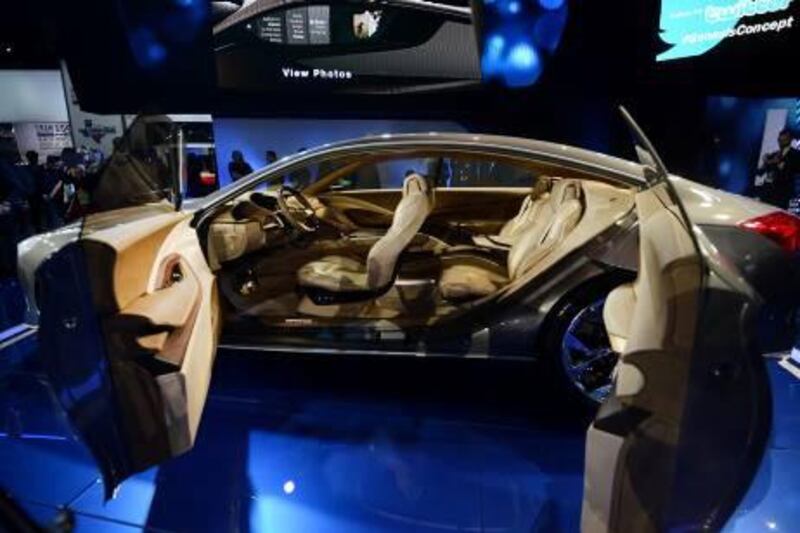If Jim Lentz's vision comes to fruition, drivers the world over will soon be able to walk up to their car while having their presence authenticated through motion sensors and facial-recognition technology.
Once a person is positively identified and waves their hand with a certain gesture, their car would flash the front lights then open the door.
Finally, through voice command, a driver could direct a virtual agent to set different options or controls of in-car features such an audio system or navigation unit.
"This is sort of like our version of Herbie the Love Bug, but highly updated and tricked out," Mr Lentz, the president of Toyota Motor Sales in the United States, said at the Los Angeles Auto Show in November.
Coming soon to a road near you: cars that can blast the air conditioning, turn down the stereo's volume or answer a phone call - all by recognising a driver's eyes or reacting to how they wave their hands.
Or so car makers hope.
Futuristic features such as these seem to be ripped straight from the scenes of a Hollywood sci-fi flick. But they are increasingly getting closer to becoming a reality.
Toyota, for one, unveiled its Smart Insect concept car last year that boasts the same kind of motion-sensing, voice-recognising and behaviour-predicting capabilities Mr Lentz describes.
At the North American International Auto Show in Detroit this month, Hyundai debuted a high-tech concept car of its own that, for the first time, utilises gesture control. Known as the HCD-14 Genesis, this vehicle has been "freed from traditional design restrictions", says Hyundai.
The company also points out designers have created a dashboard layout "devoid of intimidating clusters of buttons and knobs". The car features eye-tracking and 3D hand-gesture controls for selecting songs, navigation directions, air conditioning preferences and certain smartphone features. John Krafcik, the president and chief executive of Hyundai Motor America, says the HCD-14 Genesis "gives a hint of the design direction we'll be taking, and an indication of the focus we're placing on driving dynamics and technology".
Other car makers are also working on high-tech controls for inside their vehicles.
"It's interesting, certainly," says Mike Van Nieuwkuyk, the executive director of global automotive at JD Power and Associates, a market research firm. "The movie Minority Report comes to mind, where you're moving things about without actually touching them," he adds. "There's an element of intrigue."
Some car manufacturers have moved from the realm of fantasy to conceptual reality by turning to the videogames industry, which rebounded from troubled times through the help of motion-sensing technology and the creation of products such as Nintendo's Wii and Microsoft's Kinect for Xbox 360.
Toyota has partnered Microsoft and harnessed the software maker's Kinect intelligence, as well as Windows 8 tablet, for use in conjunction with a skateboard. The end result is what Mr Lentz calls "the board of awesomeness".
This electric skateboard runs by hand gestures, speeding up when a hand gets closer to the board and slowing down as it pulls farther away.
Elements of its design are now being scrutinised for potential use in a vehicle when it comes to controlling the volume of a radio, by lowering or raising a hand, for example.
One of the benefits of relying on gestures, rather than voice recognition, is that they can more easily control in-car features than words, which could be mispronounced or misunderstood.
"Hand gestures are pretty universal," Mr Lentz has argued.
Ford has hired the former consumer electronics designer and the strategist Parrish Hanna to help develop gesture controls for drivers.
As part of his job as global director of human-machine interface at Ford, Mr Hanna analyses how people most easily interact with gadgets.
"What I'm seeing in the industry is [competitors] still really trying what can be done, because it can be done - whether it's swiping over different locations of the vehicle, putting complex gestures into the steering wheel or embedding tablets somewhere new and putting gestures on those," says Mr Hanna.
Yet he notes Ford is trying to avoid using complicated gestures that would have to be learnt by drivers. Some laptops made by Apple, for instance, include a trackpad on which consumers can swipe two or three fingers in specific directions to pull up or hide certain applications on the screen. But some people prefer using a traditional one-finger swipe.
"We're being very cognizant of unlearnt behaviour and extreme simplicity," says Mr Hanna. "That's the direction we'll go."
For its 2013 versions of the Escape, C-Max hybrid and C-Max Energi plug-in hybrid, Ford includes a gesture-controlled tailgate feature that opens up the boot when a passenger kicks their leg just under the back of the vehicle. The feature is designed to be used by parents, for example, when they have their arms full of groceries or children and they cannot reach into their pockets to pull out the keys and pop open the boot.
"I call them embedded courtesies," says Mr Hanna. "I think we'll experiment with other cool bits that trigger some kind of mechanical operation - waving your hand to open your sunroof, or something like that."
But some car experts warn the influx of gesture-controlled gadgetry within vehicles exacerbates concerns about safety for drivers.
Mr Van Nieuwkuyk says the industry still needs to answer crucial questions about how much of a distraction these features could be. "Will this allow you to keep your eyes on the road and still manage a lot of the things you want to do?
"I don't know, honestly. I think it's too early for us to make an assessment," he says.
JD Power is set to analyse gesture- controlled car features in a forthcoming study and gauge consumer interest.
"It's great we're doing all these things but need to make them simpler to use," says Mr Van Nieuwkuyk.
"Does this simplify things is the real question."





